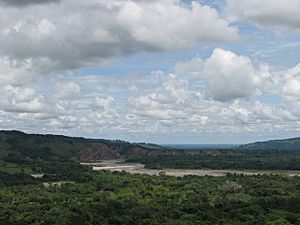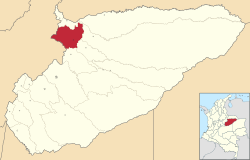Támara, Casanare facts for kids
Quick facts for kids
Támara
|
||
|---|---|---|
|
Municipality and town
|
||

View of rural Támara
|
||
|
||

Location of the municipality and town of Tamara, Casanare in the Casanare Department of Colombia.
|
||
| Country | ||
| Department | Casanare Department | |
| Founded | 6 August 1628 | |
| Founded by | José Dadey Pey | |
| Area | ||
| • Municipality and town | 1,181.81 km2 (456.30 sq mi) | |
| • Urban | 0.99031 km2 (0.38236 sq mi) | |
| Elevation | 1,156 m (3,793 ft) | |
| Population
(2015)
|
||
| • Municipality and town | 7,044 | |
| • Density | 5.9603/km2 (15.4372/sq mi) | |
| • Urban | 2,327 | |
| Time zone | UTC-5 (Colombia Standard Time) | |
| Website | Official website: http://www.tamara-casanare.gov.co/ | |
Támara is a small town and a type of local government area called a municipality in Colombia. It is located in the Casanare Department. The town sits high up, about 1,156 meters (3,793 feet) above sea level. It is about 95 kilometers (59 miles) away from Yopal, which is the capital city of the Casanare Department.
Támara shares its borders with several other towns. To the north is Sacama, to the east are Pore and Paz de Ariporo. To the west is Socotá in the Boyacá Department, and to the south are Nunchia and Paya.
History of Támara
Before the Spanish arrived, Támara was an important village. People living there were skilled at growing and producing cotton.
The modern town of Támara was officially founded on August 6, 1628. It was established by a person named José Dadey Pey.
Economy and Agriculture
The main ways people in Támara make a living are through farming and raising animals.
Farming in Támara
Farmers in Támara grow many different crops. These include coffee, yuca (also known as cassava), maize (corn), bananas, and sugarcane.
Livestock Farming
Raising animals is also a big part of the economy. This usually means keeping animals like cattle for meat or milk.
See also
 In Spanish: Támara para niños
In Spanish: Támara para niños


